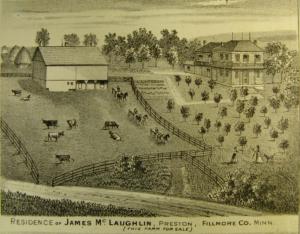 "Farmers, especially of New England, if they could but once see our lands, would never think of settling on the bilious bottoms and the enervating prairies south of us. What is fertility, what is wealth, without vigorous health and activity of body and mind? These are considerations that will weigh more in the future with the immigrants, than they hitherto have: a clear, bracing air, an invigorating winter to give elasticity to the system—and water as pure and soft as the dews of heaven, gushing from hill and valley."
"Farmers, especially of New England, if they could but once see our lands, would never think of settling on the bilious bottoms and the enervating prairies south of us. What is fertility, what is wealth, without vigorous health and activity of body and mind? These are considerations that will weigh more in the future with the immigrants, than they hitherto have: a clear, bracing air, an invigorating winter to give elasticity to the system—and water as pure and soft as the dews of heaven, gushing from hill and valley."
James M. Goodhue, editor of the Minnesota Pioneer, 1849
When Minnesota Territory was created in 1849, it was home to about 5,000 settlers and approximately 31,000 Indian people--all spread over an area that was about two and half times the size of what became, in 1858, the state of Minnesota. The settlers were predominantly white, and came either from Europe, or from British North America (Canada), or from other parts of the United States. European-American immigrants were drawn to the region by the fur trade, farming, and lumbering.
Andreas, A.T. An illustrated historical atlas of the State of Minnesota. Lakeside Building, Chicago: Chas. Shober & Co. Proprietors of Chicago Lith. Co. 1874
Gilman, Rhoda R., "Territorial Imperative: How Minnesota Became the 32nd state." Minnesota History 56 (4),1998, pp. 154-71.
Wingerd, Mary Lethert. North Country: The Making of Minnesota. Minneapolis: University of Minnesota Press, 2010.
Websites
David Rumsey Historical Map Collection.
Gibbs Museum of Pioneer and Dakotah Life
The National Archives Experience: DocsTeach
Primary
Morris, Lucy Leavenworth Wilder. Old Rail Fence Corners: Frontier Tales Told by Minnesota Pioneers. St. Paul: Minnesota Historical Society Press, 1914.
Secondary
Kenney, Dave. Northern Lights: The Stories of Minnesota’s Past. St. Paul: Minnesota Historical Society Press, 2003.
Lass, William E. "The Eden of the West," Minnesota History 56 (4),1998, pp. 204-213.




